UPSC GS 1
Ghaggar River
- News: The Punjab Chief Minister recently visited flood-prone areas along the Ghaggar river.
- Introduction: The Ghaggar River is a seasonal river that flows only during the monsoon season.
- Origin: The river rises from the Shivalik Range in northwestern Himachal Pradesh.
- Flow: It flows approximately 200 miles (320 km) southwest through Haryana state to meet the River Saraswati.
- Termination: The Ghaggar eventually dries up in the Thar Desert in Rajasthan.
- Irrigation: This seasonal river feeds two irrigation canals that extend into Rajasthan.
- Continuation: The Hakra, which flows in Pakistan, is the continuation of the Ghaggar River in India, and together they are called the Ghaggar-Hakra River.
- Historical Relevance:
-
- Ancient Identification: Several historians identify the Ghaggar with the Vedic Saraswati River.
- Indus Valley Civilization: Many settlements of the Indus Valley Civilization have been excavated along the banks of the Ghaggar River.
- Vedic Aryans: It is believed that the ancient settlements on its banks were created by the ingenious Vedic Aryans.
- Ancient Rivers: It is also believed that the rivers Sutlej and Yamuna once flowed into the Ghaggar-Hakra river bed.
-
- Tributaries: The main tributaries of the Ghaggar River are:
-
- Kaushalya River
- Markanda
- Sarsuti
- Tangri
- Chautang
-
Ghodbunder Fort
- News: The discovery of a hidden chamber beneath the inner ground layers during conservation work at Ghodbunder Fort has sparked excitement among historians.
- Introduction:
-
- Ghodbunder Fort is a hill fort located in Ghodbunder Village, Thane, Maharashtra, situated on the banks of the Ulhas River.
-

- Construction: Originally built by the Portuguese and completed in 1730.
- Name Origin: The name “Ghodbunder” derives from “Ghod” (horses) and “bunder” (fort), reflecting its use by the Portuguese for trading horses with the Arabs.
- Maratha and British Rule: The fort was later conquered by the Marathas and then taken over by the British in 1818, who used it as the district headquarters for the British East India Company.
- Materials: Constructed from stones carved out of the mountains, joined with lime, rubble, gravel, stones, molten metal, and sand.
- Structures: Includes a Portuguese church built in the early 16th century AD, along with several mansions and rooms that reflect Maratha rule.
Nalanda University
- News: PM Modi has inaugurated the new Nalanda University campus in Bihar.
- Introduction: Nalanda University stands out as the most ancient university on the Indian Subcontinent.
- Founding and Flourishing Period: Founded by Kumaragupta in the early 5th century, Nalanda gained prominence during the eras of Harshavardhan and the Pala monarchs.
- Location: Rajgir
- Nomenclature: The university’s name was derived from “Nalam” (lotus) and “da” (to give), symbolising the blossoming of knowledge.
-
- Hiuen Tsang, who visited Nalanda, attributed the name to a Naga (snake), who lived in a nearby pond.
-
- Intellectual Hub: Nalanda University was the world’s first residential university where students from around the globe came to study.
- Monastic Nature: Nalanda was primarily a place where monks and nuns lived and studied. It taught all the major philosophies of Buddhism.
- International Students: It attracted students from regions such as China, Korea, Japan, Tibet, Mongolia, Sri Lanka, and Southeast Asia.
- Dharmaganja: The university’s libraries were collectively known as Dharmaganja.
-
- They comprised three main buildings: Ratnasagara (Ocean of Jewels), Ratnodadhi (Sea of Jewels), and Ratnaranjaka (Jewel-adorned).
- The library had nine million handwritten palm-leaf manuscripts, making it the largest collection of Buddhist knowledge in the world.
-
- Illustrious Teachers: One of the most illustrious teachers of this university was Aryabhata, the renowned mathematician and astronomer, who gifted the world ‘zero’.
-
- Other notable teachers who taught at Nalanda included Dharmapala and Silabhadra.
-
- Subjects Taught: Subjects included medicine, Ayurveda, religion, Buddhism, mathematics, grammar, astronomy, and Indian philosophy.
- Destruction: Nalanda continued to be a center of intellectual activity until it was destroyed in 1193 by Turkish ruler Qutbuddin Aibak’s general Bakhtiyar Khilji.
- Rediscovery: The university was rediscovered in 1812 by Scottish surveyor Francis Buchanan-Hamilton and later identified as the ancient university by Sir Alexander Cunningham in 1861.
- Chinese Monk Xuan Zang: Xuan Zang provided invaluable insights into the academic and architectural grandeur of ancient Nalanda.
- UNESCO World Heritage Sit e: Nalanda is recognized as a UNESCO World Heritage Site.
Read more: Indian Migrants in Gulf Countries: Opportunities and Challenges UPSC
UPSC GS 2
Krishi Sakhi Convergence Program
- News: PM Modi recently granted certificates to over 30,000 women from Self Help Groups (SHGs) as ‘Krishi Sakhis’ under the Krishi Sakhi Convergence Program (KSCP).
- Definition:
-
- The Krishi Sakhi Convergence Program aims to transform rural India by empowering rural women as Krishi Sakhis, through training and certification as Para-extension Workers.
- This certification course also aligns with the objectives of the ‘Lakhpati Didi’ Program.
-
- Objectives:
-
- Empowerment of Rural Women: Empowering rural women as Krishi Sakhis.
- Training and Certification: Providing training and certification for Krishi Sakhis as Para-extension Workers.
-
- Training Components: Krishi Sakhis receive comprehensive training in various extension services, including:
-
- Agro-Ecological Practices: Training from land preparation to harvest.
- Organizing Farmer Field Schools: Facilitating practical learning sessions for farmers.
- Seed Banks: Establishment and management of seed banks.
- Soil Health and Conservation: Techniques for maintaining soil health and moisture.
- Integrated Farming Systems: Combining various farming practices for sustainability.
- Livestock Management: Basic management practices for livestock.
- Bio Inputs: Preparation, use, and establishment of bio-input shops.
- Communication Skills: Essential skills for effective communication with farmers.
-
- Refresher Training: Krishi Sakhis are now undergoing refresher training with a special focus on:
-
- Natural Farming
- Soil Health Card
- This training is being conducted through DAY-NRLM agencies in coordination with MANAGE.
-
- Implementation: The Krishi Sakhi Training Program has been rolled out in 12 states in Phase – 1:
-
- Gujarat
- Tamil Nadu
- Uttar Pradesh
- Madhya Pradesh
- Chhattisgarh
- Karnataka
- Maharashtra
- Rajasthan
- Odisha
- Jharkhand
- Andhra Pradesh
- Meghalaya
-
Lok Adalat
- News: The Supreme Court has decided to organise a special Lok Adalat from July 29 to August 3 to facilitate amicable settlements of suitable pending cases.
- Introduction:
-
- Lok Adalat is an alternative dispute redressal mechanism in India, where disputes or cases pending in court or at the pre-litigation stage are settled or compromised amicably.
-

- Legality:
-
- The Lok Adalat has been given statutory status under the Legal Services Authorities Act, 1987.
-
- Levels: Lok Adalats can be organized at the district, state, and national levels.
- Organizing Authorities: The State/District Legal Services Authority or the Supreme Court/High Court/Taluk Legal Services Committee may organize Lok Adalats at such intervals and places as deemed fit.
- Composition: Every Lok Adalat organized for an area shall consist of serving or retired judicial officers and other persons of the area as specified by the organizing agency.
-
- Generally, a Lok Adalat consists of a judicial officer as the chairman, and a lawyer (advocate) and a social worker as members.
-
- Binding Nature: Under the Legal Services Authorities Act, 1987, Lok Adalats can make awards/decisions which are deemed to be a decree of a civil court and are final and binding on all the parties concerned.
- No Appeal Provision: If the parties are not satisfied with the award of the Lok Adalat, there is no provision for an appeal against such an award.
-
- However, the parties concerned can initiate litigation by approaching the court of appropriate jurisdiction by filing a case.
-
- No Court Fee: There is no court fee payable when a matter is filed in a Lok Adalat.
- Refund of Court Fee: If a matter pending in court is referred to the Lok Adalat and settled, the court fee originally paid in the court on the complaints/petition is refunded to the parties.
- Dispute Resolution Process:
-
- Direct Interaction: Dispute resolution in Lok Adalats takes place by direct interaction of the Adalat members with the parties concerned.
- Jurisdiction: Lok Adalats possess jurisdiction over a diverse array of cases, including civil disputes, criminal cases (compoundable offences), and family matters.
-
- Nature of Cases:
-
- Pending Cases: Any case pending before any court.
- Pre-Litigation Disputes: Any dispute which has not been brought before any court and is likely to be filed before the court.
- Exclusion: Matters relating to offences not compoundable under the law shall not be settled in Lok Adalat.
-
- Permanent Lok Adalat:
-
- Establishment: The Legal Services Authorities Act, 1987, was amended in 2002 to provide for the establishment of Permanent Lok Adalats to deal with cases pertaining to public utility services like transport, postal, telegraph, etc.
- Composition: These are permanent bodies consisting of a Chairman and two members.
- Jurisdiction: They shall not have jurisdiction in respect of any matter relating to an offence not compoundable under any law. The jurisdiction of the Permanent Lok Adalats is up to Rs. 1 Crore.
- Application: Before the dispute is brought before any court, any party to the dispute may make an application to the Permanent Lok Adalat for settlement.
- After an application is made to the Permanent Lok Adalat, no party to that application shall invoke the jurisdiction of any court in the same dispute.
- Awards: Every award made by the Permanent Lok Adalat shall be final and binding on all the parties and shall be made by a majority of the persons constituting the Permanent Lok Adalat.
- Non-Compoundable Offence: A non-compoundable offence is one in which the case cannot be withdrawn by the complainant even when the complainant and the accused have reached a compromise, and a trial must necessarily follow.
-
UPSC GS 3
Bitumen
- News: India is looking to start large-scale production of bio-bitumen from biomass or agricultural waste.
- Introduction:
-
- Bitumen is a dense, highly viscous, petroleum-based hydrocarbon.
- It is found in natural deposits such as oil sands and pitch lakes or obtained as a residue from the distillation of crude oil.
-
- Composition:
-
- Hydrocarbon Molecules: Bitumen owes its density and viscosity to its chemical composition, primarily large hydrocarbon molecules known as asphaltenes and resins. These molecules are present in lighter oils but are highly concentrated in bitumen.
- Metals and Nonmetals: Bitumen often contains a high content of metals, such as nickel and vanadium, and nonmetallic inorganic elements, such as nitrogen, oxygen, and sulfur.
-
- Applications:
-
- Construction Industry: Known for its waterproofing and adhesive properties, bitumen is commonly used in the construction industry, particularly for roads and highways.
- Marine Uses: It is used to waterproof boats and other marine vessels.
- Roofing Products: Bitumen is used by companies that create and manufacture roofing products.
- Building Materials: It is used for sealing and insulating purposes in various building materials such as carpet tile backing and paint.
-
- Bio-bitumen:
-
- Definition: Bio-bitumen is a petroleum-free alternative to bitumen, or asphalt.
- Composition: It is made using non-petroleum-based renewable resources and can be produced from vegetable oils, synthetic polymers, or both.
- Sustainability: Bio-bitumen represents a more sustainable model in the long term due to its renewable resource base.
-
‘Ophichthus Suryai’
- News: Scientists of the Zoological Survey of India’s (ZSI) regional centre in Odisha have discovered a new species of snake eel called ‘Ophichthus Suryai’.
- Introduction:
-
- Ophichthus Suryai is a newly discovered species of snake eel from Odisha, India.
- This species can be distinguished from its closely allied congeners—Ophichthus alleni, Ophichthus zophistius, and Ophichthus altipennis—and other members of the genus by certain unique characteristics.
-
- Distinguishing Characteristics:
-
- Dorsal Fin Origin (DFO): The dorsal fin origin is located just above or slightly anterior to the gill opening.
- Vertebral Count and Teeth Patterns: Ophichthus suryai has a unique vertebral count and distinctive teeth patterns, with multiple rows of teeth on both the maxilla and mandible.
-
- Snake Eels Overview:
-
- Definition: A snake eel belongs to the family Ophichthidae and order Anguilliformes. These marine fishes are often mistaken for sea snakes due to their appearance.
- Habitat and Distribution: Snake eels are typically found in warm, tropical waters.
- Living Conditions: Most species live and hide in materials at the bottom of rivers or the sea. They can survive at depths of more than 2,000 feet (around 600 meters) but are often found in shallower waters.
- Physical Characteristics: Snake eels vary greatly in size, with some species growing as long as 10 feet (about 3 meters).
- The cross-section of a snake eel is almost circular.
- They have scaleless bodies, small eyes, and pointed snouts.
- Diet: The diet of a snake eel consists mainly of small fish.:They are also known to feed on crustaceans.
-
Double Sun Halo
- News: A rare celestial phenomenon known as a “double sun halo” was witnessed in the skies over Ladakh recently, leaving observers in awe.
- Introduction:
-
- A double sun halo is a rare optical phenomenon where two concentric rings appear around the sun.
- This occurs when sunlight is refracted through ice crystals suspended in cirrus clouds, creating a dazzling visual effect.
-
- Typical Sun Halo Formation:
-
- A typical sun halo, known as a 22-degree halo, features a bright ring encircling the sun at an angle of 22 degrees.
- This halo forms when ice crystals in cirrus clouds are randomly oriented, acting as natural prisms that bend and reflect sunlight at specific angles.
-
- Double Sun Halo Formation:
-
- The formation of a double sun halo is a result of the unique shape and orientation of the ice crystals in the cirrus clouds.
- These crystals, typically hexagonal in shape, act as natural prisms, refracting and reflecting the sunlight in specific angles.
- The inner 22-degree halo forms when ice crystals are randomly oriented. However, the outer 46-degree halo requires the crystals to be aligned horizontally, with their flat faces parallel to the ground. This precise alignment is rare.
- While sun halos are not uncommon in various parts of India, the appearance of a double halo is particularly rare.
-

- Regions: This phenomenon is notably observed in regions like Ladakh, where atmospheric conditions favor such occurrences.
Streptococcal Toxic Shock Syndrome (STSS)
- News: Japan is facing a record high of flesh-eating bacteria cases, with nearly 1,000 affected by Streptococcal Toxic Shock Syndrome (STSS) this year.
- Introduction:
-
- Streptococcal Toxic Shock Syndrome (STSS) is a rare but severe bacterial infection caused by group A Streptococcus (GAS) bacteria.
- It occurs when these bacteria enter deep tissues and the bloodstream, releasing toxins that cause a rapid and dangerous response in the body.
-
- Symptoms: Fever, chills, muscle aches, nausea, and vomiting.
- Progression: Within 24 to 48 hours, it can lead to low blood pressure, organ failure, rapid heart rate, and fast breathing.
- Adults vs. Children: While GAS usually causes strep throat in children, in adults it can lead to serious symptoms such as limb pain, swelling, fever, and low blood pressure.
- Contagious Nature: STSS can spread through respiratory droplets or direct contact.
- Foodborne Spread: Group A strep bacteria can also spread through food if it is not handled properly.
- Prevention: Preventing STSS involves practicing good hygiene.
Capsaicin
- News: Food safety authorities in Denmark have recalled three varieties of South Korean spicy instant noodles due to potential risks of “acute poisoning.” The food authorities stated that the noodles contain dangerously high levels of capsaicin.
- Introduction:
-
- Capsaicin is a compound most abundantly found in the “placenta” (the white membrane to which seeds are attached) of some chili peppers, which are fruits of plants belonging to the genus Capsicum.
- These plants were introduced to the rest of the world from South and Central America.
-
- Mechanism of Action:
-
- TRPV1 Receptors: Capsaicin binds to TRPV1 receptors in the human nose, mouth, skin, and insides, which are responsible for detecting heat and pain.
- Perception of Heat: The chemical tricks these receptors, making the brain perceive a burning sensation despite no actual temperature rise, leading to discomforts such as sweating, a red face, a runny nose, teary eyes, gut cramps, and diarrhea as the body attempts to cool down and expel the perceived heat-causing compound.
-
- Biological Role:
-
- Protection: Capsaicin protects chili plants from fungi and insects.
-
- Health Effects:
-
- Poisoning: Capsaicin poisoning is rare, but consuming too much can be harmful.
- Short-term Effects: High concentrations can produce heartburn, gastrointestinal pain, and diarrhea.
- Long-term Effects: Long-term ingestion of high levels may lead to chronic gastrointestinal disorders.
-
Atlantic Bluefin Tuna (Thunnus Thynnus)
- News: The Atlantic bluefin tuna now faces a new challenge of warming seas. Marine heatwaves are driving these fish to migrate northward.
- Introduction: The Atlantic Bluefin Tuna (Thunnus thynnus) is a remarkable species known for its impressive size, speed, and migratory behavior.
- Migration: They visit the coast of Ireland during the summer and autumn as part of their annual migration.
- Geographic Range: Found in sub-tropical to cold temperate latitudes of the Atlantic Ocean.
- Habitat: Inhabit the open ocean (pelagic).
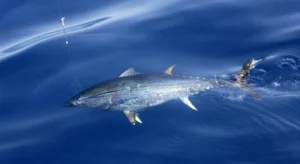
- Aggressive Predators: One of the largest open ocean predators.
- Diet: Eat fish, squid, and crustaceans.
- Reproduction: Female Atlantic Bluefin Tuna can produce up to 10 million eggs a year.
- Countercurrent Exchanger: A specialized blood vessel structure allows them to maintain a body temperature higher than the surrounding water.
- Appearance: Torpedo-shaped with short pectoral fins and a dark red dorsal fin. The back is dark blue-black, while the lower sides and belly are white.
- Constant Swimmers: Similar to some shark species, Atlantic Bluefin Tuna must constantly swim to obtain oxygen. They pass water over their gills by swimming forward with their mouths open, as they cannot breathe while stationary.
- Longevity: Atlantic Bluefin Tuna can live for 35 years, possibly longer.
- IUCN Status: Listed as “Least Concern” (LC).
Facts for Prelims
Army Chief
- News: Vice Chief of Army Staff Lt Gen Upendra Dwivedi has been appointed as the next Army Chief of India. He will assume his new role on June 30, 2024.
- The tenure for the position of Army Chief is either three years or until the officer reaches the age of 62, whichever comes first.
World Junior Chess Championship
- News: The World Junior Chess Championship 2024 was held in Gandhinagar, India.
- Kazybek Nogerbek from Kazakhstan emerged as the winner of the 2024 FIDE World Junior Chess Championship.
- In the girls’ category, Divya Deshmukh from India triumphed, claiming the title at the prestigious event in Gujarat’s Gandhinagar.

